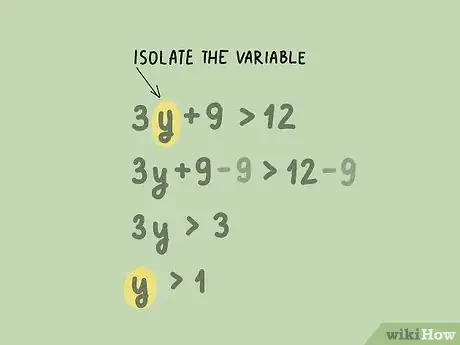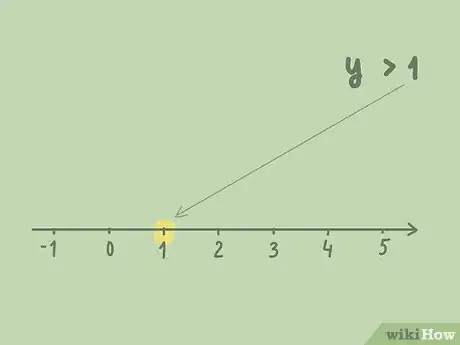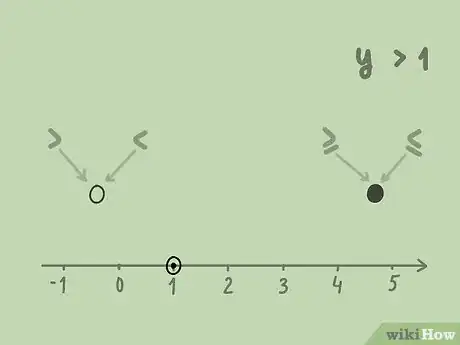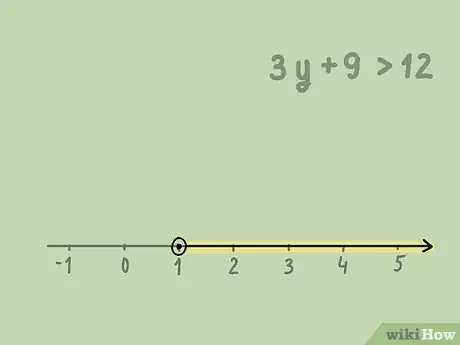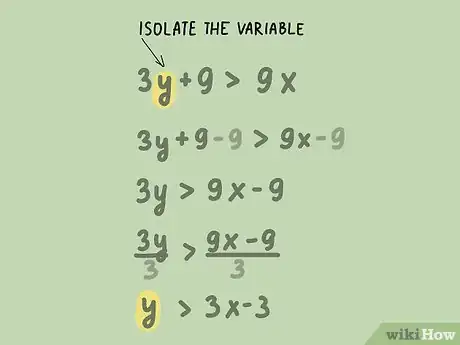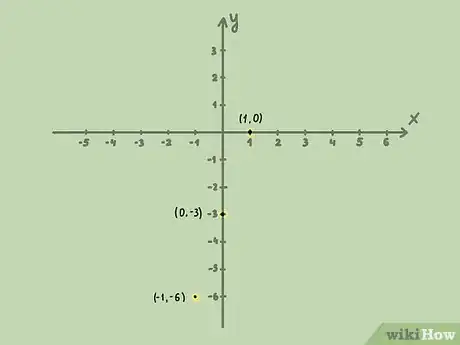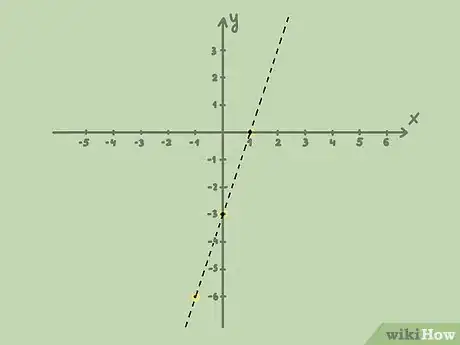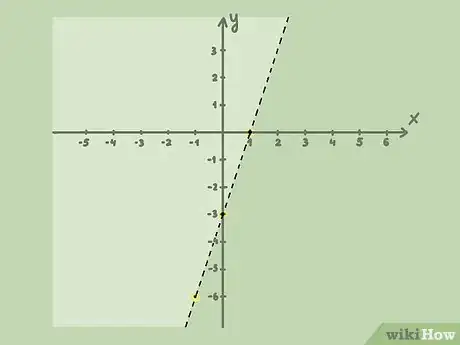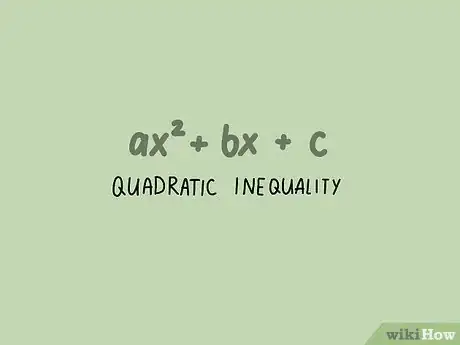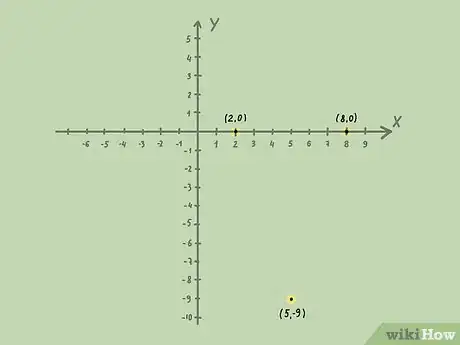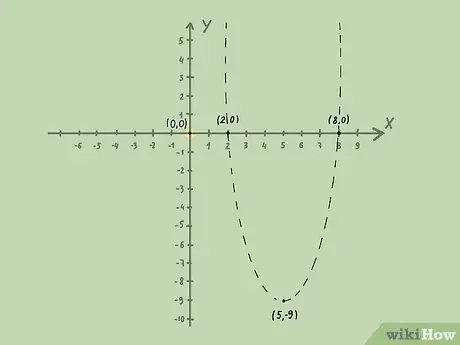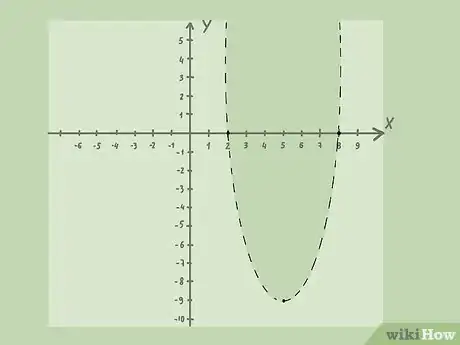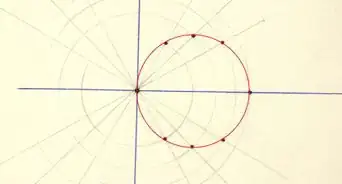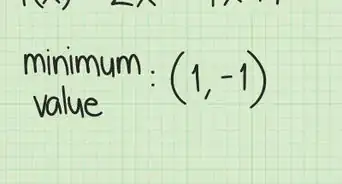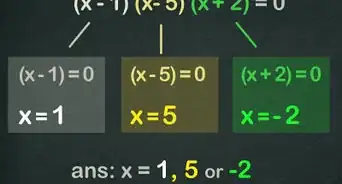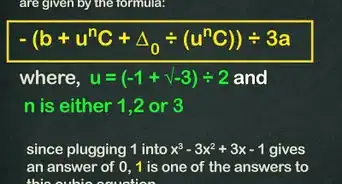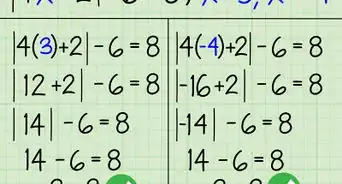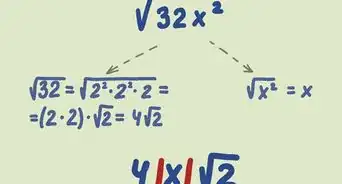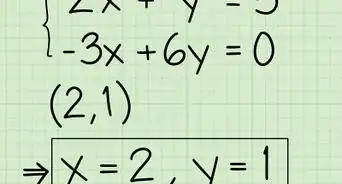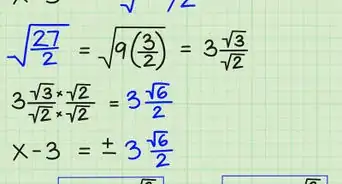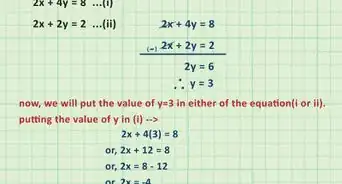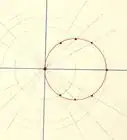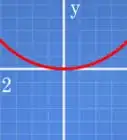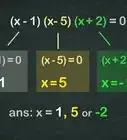This article was co-authored by wikiHow Staff. Our trained team of editors and researchers validate articles for accuracy and comprehensiveness. wikiHow's Content Management Team carefully monitors the work from our editorial staff to ensure that each article is backed by trusted research and meets our high quality standards.
There are 8 references cited in this article, which can be found at the bottom of the page.
This article has been viewed 644,219 times.
Learn more...
You can graph a linear or quadratic inequality similarly to how you would graph an equation. The difference is that, since an inequality shows a set of values greater than or less than, your graph will show more than just a dot on a number line or a line on a coordinate plane. By using algebra and evaluating the inequality sign, you can determine which values are included in the solution of an inequality.
Steps
Graphing a Linear Inequality on a Number Line
-
1Solve for the variable. To solve the inequality isolate the variable using the same algebraic methods you would use to solve an equation.[1] Remember that when you multiply or divide by a negative number, you need to flip the inequality sign.
- For example, if you are solving the inequality , isolate the variable by subtracting 9 from each side of the inequality, then dividing by 3:
- Your inequality should only have one variable. If your inequality has two variables, it is more appropriate to graph it on a coordinate plane using another method.
- For example, if you are solving the inequality , isolate the variable by subtracting 9 from each side of the inequality, then dividing by 3:
-
2Draw a number line. Include the relative value on your number line (the value you found the variable to be less than, greater than, or equal to). Make the number line as long or short as required.
- For example, if you found that , make sure to include a point for 1 on the number line.
Advertisement -
3Draw a circle indicating the relative value. If the value is less than () or greater than () this number, the circle should be open, since the solution does not include the value. If the value is less than or equal to (), or greater than or equal to (), the circle should be filled in, since the solution includes the value.[2]
- For example, if , you would draw a circle at 1 on the number line. You would not fill in the circle, since 1 is not included in the solution.
-
4Draw an arrow indicating the included values. If the variable is greater than the relative value, your arrow should point to the right, since the solution includes values greater than that number. If the variable is less than the relative value, your arrow should point to the left, since the solution includes values less than that number.[3]
- For example, for the solution , you would draw an arrow pointing to the right, since the solution includes values greater than 1.
Graphing a Linear Inequality on a Coordinate Plane
-
1Solve for . You want to find the equation of the line, so to do this you need to isolate the variable on the left side of the equation using algebra.[4] The right side of the equation should have the variable, and likely, a constant.
- For example, for the inequality , you would isolate the y variable by subtracting 9 from both sides, then dividing by 3:
- For example, for the inequality , you would isolate the y variable by subtracting 9 from both sides, then dividing by 3:
-
2Graph the line on a coordinate plane. To do this, turn the inequality into an equation, and graph as you would any equation of a line.[5] Plot the y-intercept, then use the slope to graph other points on the line.
- For example, if the inequality is , you would graph the line . The y-intercept (the point where the line crosses the y axis) is -3, and the slope is 3, or . So, you would draw a point at . The point above the y-intercept is . The point below the y-intercept is .
-
3Draw the line. If the inequality is less than () or greater than (), the line should be dashed, since the solution does not include values equal to the line. If the value is less than or equal to (), or greater than or equal to (), the line should be solid, since the solution includes values equal to the line.[6]
- For example, since the inequality is , the line should be dashed, since the values do not include points on the line.
-
4Shade in the appropriate area. If the inequality shows you should shade in the area above the line. If the inequality shows , you should shade the area below the line.[7]
- For example, for the inequality you would shade above the line.
Graphing a Quadratic Inequality on a Coordinate Plane
-
1Determine whether you have a quadratic inequality. A quadratic inequality takes the form of .[8] Sometimes there may not be an term or a constant, but there should always be an term on one side of the inequality, and an isolated variable on the other side.
- For example, you might need to graph the inequality .
-
2Graph the line on a coordinate plane. To do this, turn the inequality into an equation, and graph the line as you normally would. Since you have a quadratic equation, the line will be a parabola.[9]
- For example, for the inequality , you would graph the line . The vertex is at point , and the parabola crosses the x-axis at the points and .
-
3Draw the parabola. Draw the parabola with a dashed line if the inequality is less than () or greater than (). If the value is less than or equal to (), or greater than or equal to (), you should draw the parabola with a solid line, since the solution includes values equal to the line.[10]
- For example, for the inequality , you would draw the parabola with a dashed line.
-
4Find some test points. In order to determine which area to shade, you need to pick points from inside the parabola, and from outside the parabola.[11]
- For example, the graph of the inequality shows that the point is outside the parabola. This would be a good point to use to test the solution.
-
5Shade the appropriate area. To determine which area to shade, plug the values of and from your test points into the original inequality. Whichever point produces a true inequality indicates which area of the graph should be shaded in.[12]
- For example, plugging the values of and of the point into the original inequality, you get:
Since this is true, you would shade the area of the graph where the point is found. In this case, this is outside of the parabola, not inside of it.
- For example, plugging the values of and of the point into the original inequality, you get:
Community Q&A
-
QuestionHow do I graph the inequality y is less than or equal to X + 6?
 Community AnswerSince you do not have an x-squared term, you are working with a linear inequality. Turn the inequality into the equation y = x + 6. Plot the line using this equation. Since it is in the form of y = mx + b, you can tell that the y-intercept is at the point (0, 6), and that the slope is 1, or 1/1. Since it is less than OR equal to, the line should be solid. Since y is less than the line, you would shade the area below the line.
Community AnswerSince you do not have an x-squared term, you are working with a linear inequality. Turn the inequality into the equation y = x + 6. Plot the line using this equation. Since it is in the form of y = mx + b, you can tell that the y-intercept is at the point (0, 6), and that the slope is 1, or 1/1. Since it is less than OR equal to, the line should be solid. Since y is less than the line, you would shade the area below the line. -
QuestionHow do I graph x - y is greater than 5 as a linear inequality?
 Community AnswerFirst, substitute "greater than" with "equals," which gives you x - y = 5. Then rearrange the equation to get y = x - 5. Input some values for x. If you do 1, 5, 10, you get y-values -4, 0, 5. Plot these 3 points (1,-4), (5,0) and (10,5). Then pick a point on your graph (not on the line) and put this into your starting equation. Take the point (4,2) for example. You have 4 - 2 > 5, and 2 > 5 is false. This means that the graph area on the same side of the line as point (4,2) is not in the region x - y > 5. Therefore, any point on the other side of the line should be in this region. To check, use point (8,2). 8 - 2 > 5, 6 > 5, which is true. You can then draw arrows off your line indicating the region represented by x - y > 5.
Community AnswerFirst, substitute "greater than" with "equals," which gives you x - y = 5. Then rearrange the equation to get y = x - 5. Input some values for x. If you do 1, 5, 10, you get y-values -4, 0, 5. Plot these 3 points (1,-4), (5,0) and (10,5). Then pick a point on your graph (not on the line) and put this into your starting equation. Take the point (4,2) for example. You have 4 - 2 > 5, and 2 > 5 is false. This means that the graph area on the same side of the line as point (4,2) is not in the region x - y > 5. Therefore, any point on the other side of the line should be in this region. To check, use point (8,2). 8 - 2 > 5, 6 > 5, which is true. You can then draw arrows off your line indicating the region represented by x - y > 5. -
QuestionHow do I graph y=5x+1?
 Community AnswerThe Y-axis goes up and down; the X-axis goes left and right. Plug in x values: In the equation above, if x is 0, what is y? Plugging 0 in for x and doing the calculation gives a 1 for y. The first point, then, is (0,1). (When x is 0, y is 1.) Next, plug in 1 for x. (5 times 1) + 1 = 6. So the next point is (1,6). (When x is 1, y is 6.) Now, plug in 2 for x. (5 times 2) + 1 = 11. The next point is (2,11). Plot the points on the graph and draw a line through all of them.
Community AnswerThe Y-axis goes up and down; the X-axis goes left and right. Plug in x values: In the equation above, if x is 0, what is y? Plugging 0 in for x and doing the calculation gives a 1 for y. The first point, then, is (0,1). (When x is 0, y is 1.) Next, plug in 1 for x. (5 times 1) + 1 = 6. So the next point is (1,6). (When x is 1, y is 6.) Now, plug in 2 for x. (5 times 2) + 1 = 11. The next point is (2,11). Plot the points on the graph and draw a line through all of them.
References
- ↑ http://www.virtualnerd.com/algebra-2/equations-inequalities/linear-inequalities/solve-multi-step-inequalities/inequality-two-step-solution-and-graph
- ↑ http://www.purplemath.com/modules/ineqlin.htm
- ↑ http://www.purplemath.com/modules/ineqlin.htm
- ↑ http://www.mathsisfun.com/algebra/graphing-linear-inequalities.html
- ↑ http://www.mathsisfun.com/algebra/graphing-linear-inequalities.html
- ↑ http://www.purplemath.com/modules/ineqgrph.htm
- ↑ https://www.khanacademy.org/math/algebra/x2f8bb11595b61c86:inequalities-systems-graphs/x2f8bb11595b61c86:graphing-two-variable-inequalities/a/graphing-inequalities-x-y-plane-review
- ↑ https://www.mathsisfun.com/algebra/inequality-quadratic-solving.html
- ↑ http://www.virtualnerd.com/algebra-2/quadratics/inequalities/graphing-solving-inequalities/graph-inequality
About This Article
To graph linear inequalities, isolate the variable and solve the problem. Then, draw a vertical or horizontal number line that includes the value that the variable is greater or less than, and draw a circle on the tick mark of the relative value. Draw an arrow from that value to the greater or less than side of the number line, depending on the equation. For example, for an equation that solves as y > 1, you would draw a circle on 1 and an arrow pointing up, since the solution includes all values greater than 1. If you want to learn how to graph the inequality on a coordinate plane, keep reading the article!
